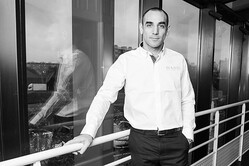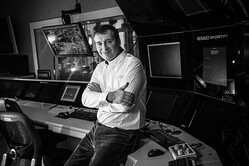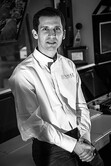


28/01/2015
NEWS STORY
 Renault F1 managing director Cyril Abiteboul, chief technical officer Rob White and head of operations Remi Taffin look ahead to the new season.
Renault F1 managing director Cyril Abiteboul, chief technical officer Rob White and head of operations Remi Taffin look ahead to the new season.
It's been a short winter break this year, but Renault Sport F1 has nevertheless made a lot of progress. Can you explain the areas where you have moved forward?
Cyril Abiteboul: In the short gap between seasons we have taken a number of steps forward. First and foremost we have implemented a new organizational structure.
Our new structure will emphasize the need for perpetual change and adaptation within Renault Sport F1. This will be achieved through two new functions. As Chief Technical Officer, Rob White will use his in-depth knowledge of Renault Sport F1 to set the road map and a strategy for the acquisition, development and utilization of technical skills within the company, always with a close eye on our F1 project. As everyone knows, F1 performance is driven by human performance so we have created another stream in parallel to manage all organizational matters, procedures and protocols. Jean-Paul Gousset, who was previously head of production, is now responsible for this area, from the small details to the large changes that together create the racing spirit we want to see in Viry-Chatillon.
Another substantial change is the creation of the Development Department, headed by Naoki Tokunaga. In addition to overseeing the Engineering Department, which is still managed by Jean-Philippe Mercier, Naoki will be directly responsible for Performance and Reliability Groups.
With all our operations streamlined, there will be a seamless link between factory and track, giving further leverages for managing the workforce and activity workloads, plus will create career paths. Rémi Taffin will oversee all track and factory operations, including assembly and dynos, in addition to his previous role as head of track operations. Regrouping everything under one person simplifies our lines of communications, allowing us to respond to changes or needs more quickly and ensure overall quality control and cost efficiency.
What advantages do you hope to gain from this new structure?
CA: It is still very early to see the direct effects but all the changes are made for long term gain. We should start to see the full impact in development by the mid-season with greater flexibility, dynamism and efficiency across all our operations.
Are the changes linked directly to 2014 performance?
CA: Not specifically. F1 constantly moves forward at a very fast rate. The sport evolves, technology evolves and the competition never sleeps so Viry needs to evolve at the same rate. Viry needed a refresh. We did not suffer from a lack of resources or finances in 2014, it was simply that the resources were not joined up in time or used to their optimum. We are not in any way pointing fingers at individuals, these changes are simply to improve the collective.
How will the changes benefit Renault's partner teams?
CA: The performance and reliability groups are tasked with clear responsibilities and allow us to get closer to the model of F1 teams nowadays, which should build natural bridges and synergies with our customers. Replicating the structure of a team in our own organization means we will fit more easily into the team culture and create more natural communications. With fewer 'hurdles' to jump we should be more creative, freer to execute decisions and implement actions as a result.
Will personnel from the larger Renault Group continue to be seconded to Renault Sport F1?
CA: Yes, more than ever. We need to create strong and genuine links between road cars and competitive sport in both directions. Renault needs to help our F1 division and F1 needs to help Renault. The personnel we have on board bring new knowledge to us and, in turn, take some lessons of F1 back to road car development when they return. At present there are Renault personnel in several departments that will bring gains to road car areas, for example, fuel efficiency and electrical systems.
What are Renault Sport F1's aims for 2015?
CA: We knew what we had to do over the winter and we know what we have achieved. We believe we have made a very big step in performance and will be more reliable. We do not know where the others will be: we may not have erased all the gaps, but we are confident that we have gone a long way to making up the deficit of last season. Our objective is to close the gap as much as possible and give Red Bull Racing and Scuderia Toro Rosso a more competitive car on most circuits, independently of their characteristics and sensitivities.
 What are the challenges going into the second year of the power units?
What are the challenges going into the second year of the power units?
Rob White: Year two of a new engine is always difficult. The 2015 power unit project was started six months before the 2014 units took to the track, ie. before we had any significant experience of the technology. Then we also need to consider the issues arising during the season. It creates a need to be both forward thinking and reactive.
Splitting resources between projects is a delicate balancing act, in the short, mid and long term. While certain decisions can be taken upstream, a number of design decisions were taken quite late in the day, in order to benefit from the experience of the 2014 power unit. The result is a power unit that is very different to its predecessor.
What are the principal changes to the Renault Energy F1 for the 2015 season?
RW: We have made some fundamental changes to gain performance and reliability. We have upgraded every system and subsystem, with items that will give the most performance prioritized. The principal changes involve the internal combustion engine, turbocharger and battery. The ICE will have a new combustion chamber, exhaust system concept and variable trumpets, as permitted by the 2015 regulations. The compressor is more efficient, while the energy recovery systems are able to deal with more severe usage.
The 2014 unit was already well placed in its centre of gravity, however we have tidied up the packaging to give greater ease of integration into the chassis. Additionally many systems and functions have been rationalized and simplified to further ease the task. In short, there are very few carry over pieces between the 2014 and 2015 power units.
This year the power unit is broken down into 'tokens'. How does this system work?
RW: This year there are regulatory limits to do with 'token' spend that determine the number of changes we can make. The power unit is divided into sections and then subassemblies associated to it. The total number of tokens within the power unit is equal to 66. Five out of the 66 tokens are not available for change as they are frozen. An engine manufacturer is able to select 32 token areas, or 48% of the engine, which he would like to change. As the technology gets more mature next year and beyond there will be fewer and fewer tokens
available to spend. Clearly the juggling act we need to perform is which areas of the power unit are the most worthwhile to attack for performance reasons.
How has Renault decided to allocate its tokens?
RW: We have used the majority of the tokens for the first race and our use of tokens during the course of the season will be relatively modest. It then becomes a matter of strategy about when you introduce the remaining tokens; whether to introduce at the start of the season when the technology is relatively immature but could give greater relative performance, or later in the season when the part has had more testing miles but the impact on performance will be potentially less. We can still make changes for reliability under the sporting regulations. We have therefore prioritized token spend to make as much headway as possible with performance.
What are your aims for 2015?
RW: First and foremost we need to run reliably, be quick and closer to front. Our honest expectation is that we will make a decent improvement but it is difficult to quantify the gain relative to our competitors who will also progress. What we can say is that we are on course to make a significant performance step and resolve the principal reliability weaknesses by the time we get to the first race.
 Are there any particular areas of the power unit you have worked on to give performance?
Are there any particular areas of the power unit you have worked on to give performance?
Remi Taffin: We have made lots of changes to the power unit across all areas from last year. We won't go into specifics about each and every part we have changed, but we will arrive in Melbourne with a very different engine to last year. This year we can cash in up to 32 tokens over the season and we plan to use a great deal for Australia, with some
saved for use during the year to give flexibility.
Reliability is also a big topic in 2015, with only four power units permitted this year. What steps have you taken to improve reliability?
RT: Admittedly last year our reliability record was not the best we could have hoped for but we worked very hard in this area and made some real improvements on reliability in the second part of the year. In fact we already had 2015 in mind last year as we ran all parts to the life expected this season. That is, instead of running for the distance demanded by a five-per-year cycle, we tested them based on a four-per-year cycle, or 20% more than required. Even though we pushed the parts harder than they needed to go last year, it gave us the starting point for 2015.
How has the reduction in units changed your approach?
RT: Having just four units to play with this year certainly gives us less flexibility and when a part has an issue it will be a lot more difficult to use again. However we feel prepared knowing that the parts have been running to the lifecycle needed for some time with few issues.
With two teams in 2015, how has the structure of the track operations changed?
RT: With two teams this year, both of which are part of the Red Bull family, we have been able to allocate resources in a more effective way. Each team will have a track support leader overseeing the engine engineers and technicians - one more person than previously. In the past the track support leader would also run a car, but this year his role will be to make sure the entire operation at the track works as well as possible rather than specifically look after one driver. This effectively frees them to look at all areas of the power unit and performance as a whole. The two track support leaders will also be able to share information between themselves, doubling the data we have per session and, in theory, moving forward at a much quicker rate.
And how have operations at the factory been modified?
RT: In the past assembly, dynos and track operations were linked but essentially separate departments, but now they will be regrouped under the banner of operations to create a seamless link between factory and track. From the arrival of the parts, through to inspection, assembly, dyno testing and then running on track, one department will be responsible. Accordingly resources have been reallocated based on our updated priorities, allowing us to homogenize and optimize our decisions and subsequent actions.
What advantages will this update bring?
RT: Formula 1 is a fast-paced industry and having one department running operations streamlines everything. When decisions need to be taken, they can be made much quicker, and we will be able to allocate budget and resources to implement them. The framework was already there, but we have just trimmed things down and rationalized the structure. We should therefore be able to respond faster to requests and requirements, which will in turn bring greater reliability and performance from our technology.